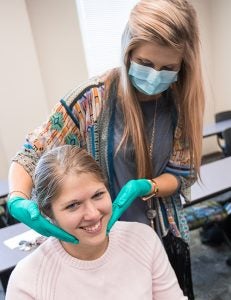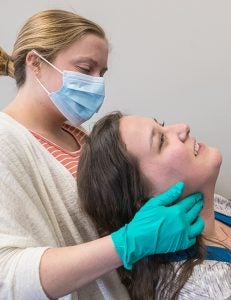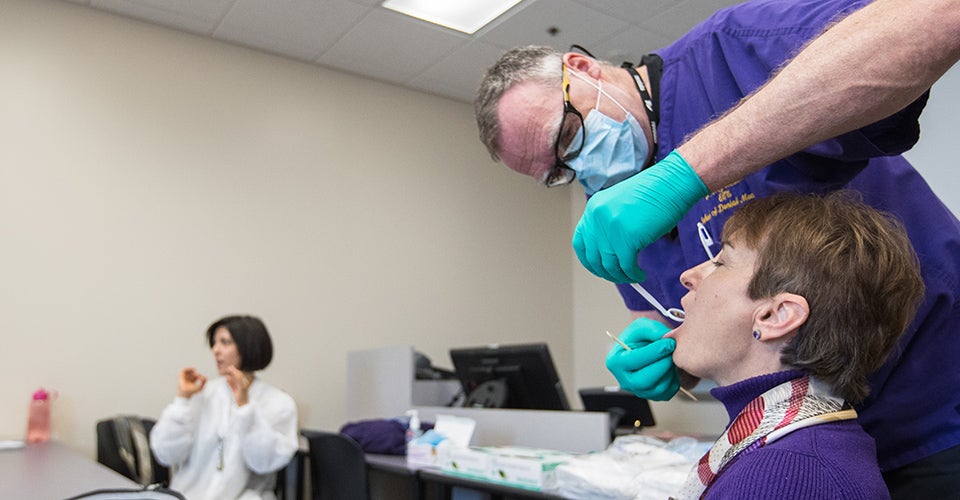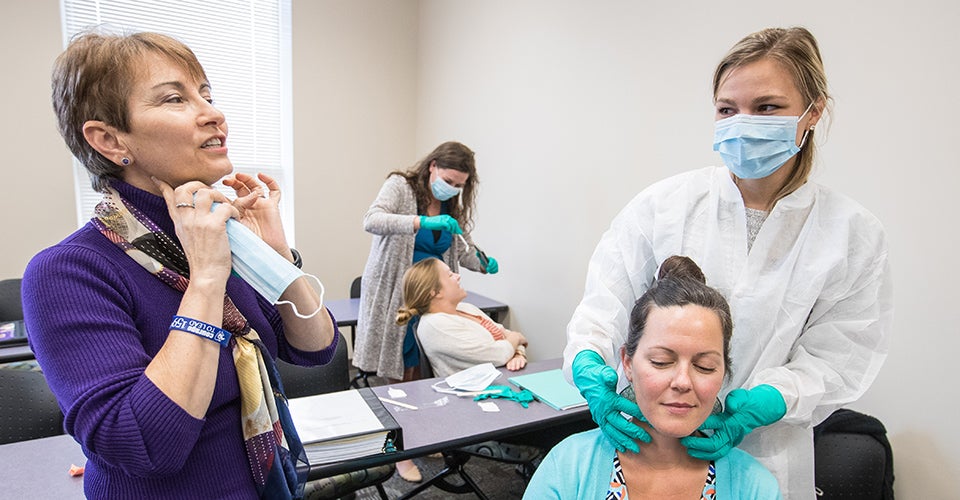'NO FENCE'
Dental faculty teach nutrition students, interns to read oral signs of malnutrition
As the gateway to the body’s internal organs, the mouth introduces the foods that keep us nourished and well. The mouth can also reveal signs of nutrition disorders to health professionals who know what to look for.
That was the focus of an April 7 workshop hosted by East Carolina University School of Dental Medicine faculty members for dietetic interns and master’s students in ECU’s Department of Nutrition Science.
“Today’s workshop is a ‘first’ for dental and nutrition science faculty collaboration,” said Dr. Geralyn Crain, dental faculty member and interim assistant vice chancellor for interprofessional collaboration for the ECU Division of Health Sciences. “I’d like to see the dental and nutrition science areas become regular partners,” she said.

Keri Biles performs a practice oral exam on fellow dietetic intern Erin Jones.
Dental faculty members Dr. Nisha Ganesh and Dr. Troy Sluder shared a presentation that dealt with building an interprofessional oral health team. They illustrated normal structures in the oral cavity, demonstrated how to perform oral exams, and helped workshop participants perform oral exams on each other
Then the dental school’s pathologist, Dr. Bobby Collins, delivered a slide show about the oral manifestations of nutrition deficiency to help students recognize oral abnormalities that require nutritional and medical interventions.
Dr. Sylvia Escott-Stump, clinical assistant professor in the Department of Nutrition Science and director of East Carolina’s dietetic internship program, said that malnutrition includes not only under-nutrition, but also over-nutrition or obesity.
“What people assume, including some doctors, is that people who are overweight are well nourished, though their diet might be terrible, like eating all fats or all sugars,” Escott-Stump said. “So nutritionists need to be able to recognize signs of malnutrition, which can often be detected in the mouth and eyes.”
Dietetic intern Karen Neunzig said that oral exams are not part of nutritional assessments for patients at the Whiteville hospital where she works.
“I can see where using an oral-based exam in unison with lab values and diet recall could be quite effective in getting a clear picture of a patient’s nutrition status,” she said following the workshop.

Sarah Stephens practices an oral exam on Julie Johnson. Both are dietetic interns.
Crain and a leadership team from across the health sciences division are exploring ways to promote and support interprofessional practice, learning, research and service throughout the division as part of a growing trend toward a patient-centered, collaborative approach to health care.
“There is no fence blocking inflammation caused by periodontal disease – that is, the effects of diseases of the gums and bone structure around the teeth – from spreading to other organs of the body,” said Crain. “There is growing evidence in the connection between the inflammation caused by periodontal disease and heart disease, low neonatal birth weight and preterm delivery, and other disorders.
“It’s time to put the mouth back in the body and realize the importance of the mouth when assessing patient health,” Crain added.
Crain said there is a current trend among primary care doctors to include examination of the oral cavity as part of the routine exam that evaluates a patient’s head, ears, eyes, nose and throat.
Under Crain’s leadership, the School of Dental Medicine – the newest school in the Division of Health Sciences – joins the Brody School of Medicine, College of Nursing and College of Allied Health Sciences in the interprofessional work they have been engaged in for a number of years.
In recent collaborations, students in the accelerated second-degree Bachelor of Science in nursing program helped screen patients for the dental school’s clinics;general dentistry practice residents provided instruction in oral health screening and examination for nurse-midwifery students in ECU’s College of Nursing. And dental students helped to establish a Prenatal Oral Health Program in collaboration with the Brody School of Medicine’s obstetrics and gynecology clinic.
“The learning between professions needs to go both ways,” Crain said. “For example, we are exploring ways to incorporate more nutrition science education into the dental school curriculum and clinics, and we’ll look to our nutrition science colleagues at ECU for partnership. There are so many ways that the health sciences can collaborate that will lead to reduced health care costs and enhanced patient outcomes.”

Dental faculty member Dr. Troy Sluder demonstrates how to perform an oral exam during a recent workshop that dental faculty held for nutrition students and dietetic interns.
